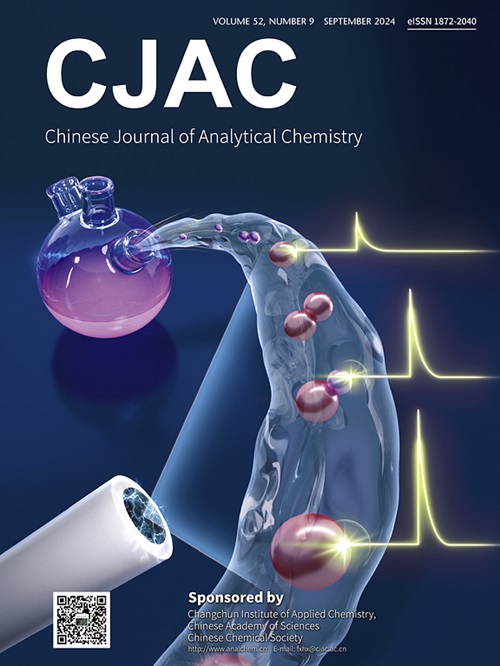采用UPLC-QTOF-MS和UFLC-QQQ-MS同时进行定性和定量分析,探讨大承气汤不同配方产生不同疗效的物质基础
IF 1.3
4区 化学
Q4 CHEMISTRY, ANALYTICAL
引用次数: 0
摘要
大承气汤(DCQD)是《尚寒论》中著名的通便方剂,由大黄、厚朴、枳实、芒草4种中药成分组成。由于其成分复杂,传统煎制工艺不一致,保持其质量和探索其功效的物质基础具有挑战性。本研究建立了超高效液相色谱-四极杆飞行时间质谱联用(UPLC-Q-TOF-MS)和超快速液相色谱-三重四极杆质谱联用(UFLC-QQQ-MS)相结合的方法,对不同配方的DCQD进行定性和定量分析。通过优化流动相组成、梯度和流速等参数,改进了不同配方中主要成分的质量控制和含量检测方法。通过对方法的优化,大大提高了芦荟大黄素、大黄素、芹菜素等结构相似物质的分离能力。结果,在定性分析中,共检测到190个成分,其中27个化合物通过色谱行为和质谱与参比化合物的比较得到了明确的鉴定,其余化合物通过与已发表文献或已知数据库中的碎片路径和特征碎片离子的比较初步确定。在定量分析中,测定了10个配方中19种关键成分的含量。结果表明,部分成分大致按中草药的比例分布,如大黄酸、没食子酸、百思力、橙皮苷和柠檬苦素。但大黄素、橙皮苷、辛佛林、厚朴酚等大部分成分的分布与中草药有较大差异,产生增溶作用或抑制溶出作用,这可以解释不同剂型治疗肠梗阻、胰腺炎等疾病的效果差异。本研究为鉴别和定量DCQD中主要成分提供了一种简单、快速、准确的方法,为探究DCQD不同配方对胃肠道疾病产生不同疗效的机理做了准备。本文章由计算机程序翻译,如有差异,请以英文原文为准。

Simultaneous qualitative and quantitative analysis to explore the material basis for different formulations of Dachengqi decoction to produce different efficacy by UPLC-QTOF-MS and UFLC-QQQ-MS
Dachengqi Decoction (DCQD) is a well-known prescription of catharsis in “Shang Han Lun”, composed of 4 traditional Chinese medical ingredients: Radix et Rhizoma Rhei (Dahuang), Cortex Magnoliae officinalis (Houpo), Fructus Aurantii Immaturus (Zhishi) and Natrii Sulfas (Mangxiao). Due to the complexity of its composition and inconsistencies in the traditional decocting process, maintaining the quality and exploring the material basis for efficacy of DCQD are challenging. In this study, we established an integrating ultra-high-performance liquid chromatography equipped with quadrupole time-of-flight mass spectrometry (UPLC-Q-TOF-MS) and ultra-fast-performance liquid chromatography equipped with triple quadrupole mass spectrometry (UFLC-QQQ-MS) method to perform qualitative and quantitative analyses of different DCQD formulations. The methods of quality control and content detection of the main components of different formulations were improved by optimizing the parameters of mobile phase composition, gradient and velocity. By optimizing of the method, the separation ability of structurally similar substances such as aloe-emodin, emodin and Apigenin is greatly improved. As a result, in the qualitative analysis, 190 components were detected of which 27 compounds were unambiguously identified by comparison with reference compounds by chromatographic behavior and mass spectrum, and the remaining compounds were tentatively assigned by comparison with fragmentation pathways and characteristic fragment ions in published literature or known databases. In the quantitative analysis, the contents of 19 key ingredients across 10 formulations were determined. The results showed that some components were roughly distributed according to the proportion of Chinese herbs, such as rhein, gallic acid, physcion, hesperetin and limonin. However, the distribution of most components differed greatly from that of Chinese herbs, such as emodin, hesperidin, synephrine and honokiol, producing solubilization effect or inhibition of dissolution effect, which could explainned the varied effects of different formulations in treating conditions like intestinal obstruction and pancreatitis. This study provides a simple, fast and accurate method to identify and quantify the main components in DCQD, and makes preparations for exploring the mechanism of different formulations of DCQD to produce different efficacy in gastrointestinal disease.
求助全文
通过发布文献求助,成功后即可免费获取论文全文。
去求助
来源期刊
CiteScore
3.60
自引率
25.00%
发文量
17223
审稿时长
35 days
期刊介绍:
Chinese Journal of Analytical Chemistry(CJAC) is an academic journal of analytical chemistry established in 1972 and sponsored by the Chinese Chemical Society and Changchun Institute of Applied Chemistry, Chinese Academy of Sciences. Its objectives are to report the original scientific research achievements and review the recent development of analytical chemistry in all areas. The journal sets up 5 columns including Research Papers, Research Notes, Experimental Technique and Instrument, Review and Progress and Summary Accounts. The journal published monthly in Chinese language. A detailed abstract, keywords and the titles of figures and tables are provided in English, except column of Summary Accounts. Prof. Wang Erkang, an outstanding analytical chemist, academician of Chinese Academy of Sciences & Third World Academy of Sciences, holds the post of the Editor-in-chief.

 求助内容:
求助内容: 应助结果提醒方式:
应助结果提醒方式:


